We have a bird bath in our front yard and love to watch the birds splashing happily and enjoying a drink. But if not maintained properly, a dirty bird bath is less attractive to birds and can actually spread disease to both birds and humans. So here’s a quick lesson on both how to keep bird bath water clean and how to clean a bird bath with vinegar or bleach.
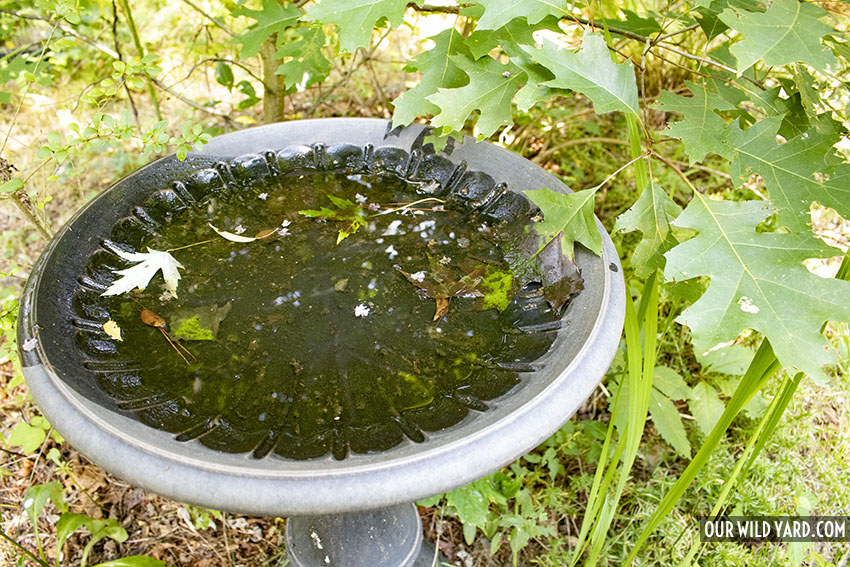
Why Should I Clean my Birdbath?
Why is it so important to clean a bird bath? Birds can spread diseases like House Finch Eye Disease to each other by visiting bird feeders and baths. And now, a new mystery disease is killing songbirds in the east so it’s more important than ever to learn how to clean a bird bath.
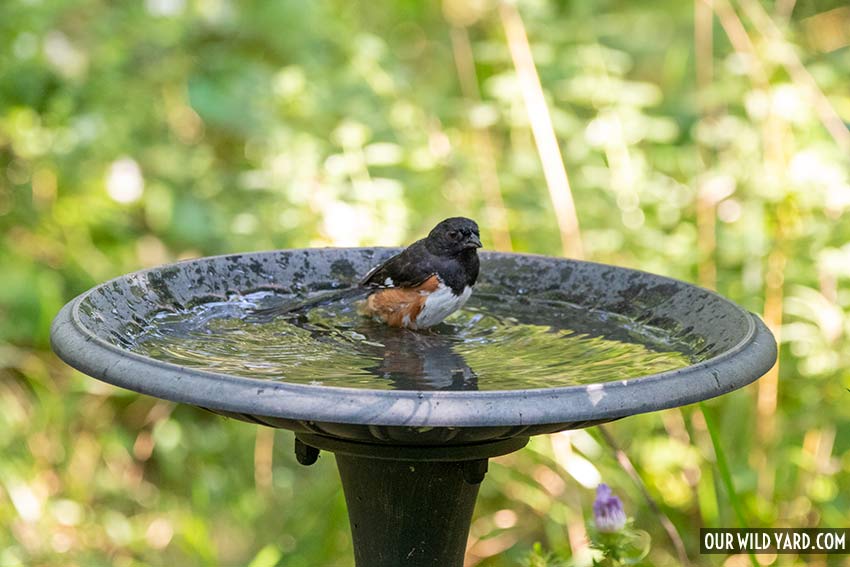
Baths and feeders can also spread diseases to pets and humans. For example, wild birds can carry Salmonella germs while appearing perfectly healthy. According to the CDC “you can get sick (from Salmonella) when you touch your mouth with unwashed hands after touching wild birds, bird feeders or bird baths, or your pets that have contact with wild birds.”
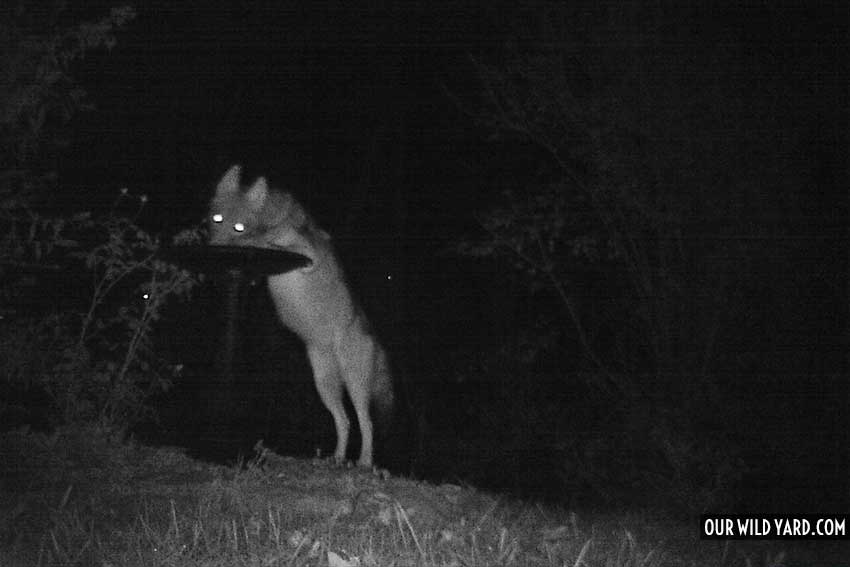
Plus, if you don’t change your birdbath water frequently, you will definitely have mosquitoes breeding in it. Mosquitoes will lay eggs in any still body of water, and Culex species, which are most likely to transmit West Nile Virus, will frequently lay eggs in bird baths. West Nile Virus is the leading cause of mosquito-borne disease in the continental United States and is dangerous for birds too. Help stop the spread by frequently cleaning your bird bath. During the 2016 outbreak of Zika Virus (another mosquito-borne disease) the CDC also recommended cleaning out birdbaths, pointing out that mosquitoes lay eggs on the walls of water-filled containers and that the eggs stick to containers like glue and remain attached until they are scrubbed off.
How To Keep Bird Bath Clean
The easiest way to keep bird bath water clean is to simply change the water every day or two. In our house, Cristina is the vigilant maintainer of the bird baths and she simply carries out a pot full of cold water from the kitchen sink. We also keep a scrub brush handy nearby to remove any algae or debris. Here’s our simple routine of how to keep a bird bath clean that you should follow every couple days.
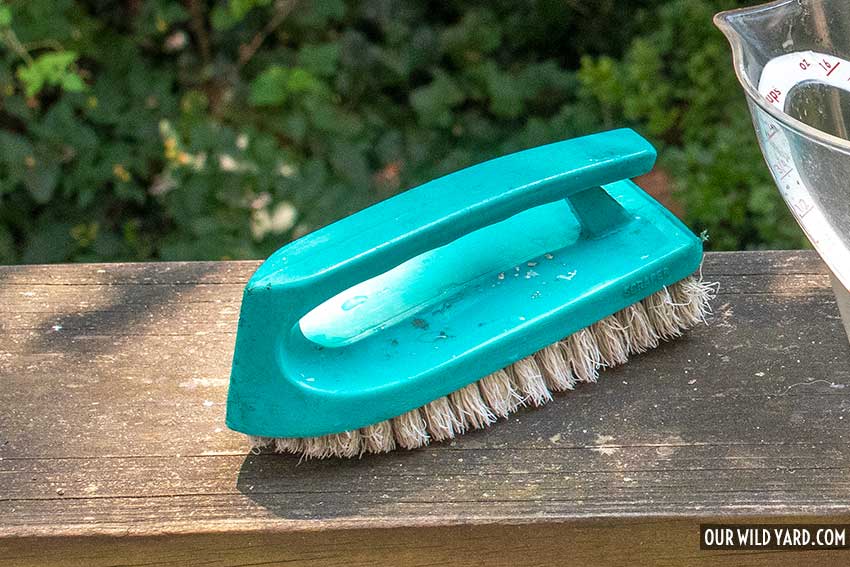
- Fill a cooking pot with cold water at the kitchen sink and carry it out to the bird bath. We just use our standard 2.5 quart cooking pot because there’s always one handy. Use any container you want or a hose if you have one nearby!
- Dump out the old water from the bird bath and then pour in a splash of fresh water for step 3.
- Grab your handled scrub brush and vigorously scrub the inside of the bath. (We leave our brush outside near the bath so we don’t have to search for it every time.) This removes any algae growth, mosquito eggs, or debris like bird poop and plant matter.
- Dump out the dirty scrub water and then rinse it out with another splash of fresh water.
- Fill the bath with the remaining water in your pot! You might need a second pot if you have a larger bath, but ideally the water should be no more than 2 inches deep.
- Wash your hands before touching your mouth or eating. You can transmit germs like Salmonella from touching bird baths!
Be sure to check out: How To Make a Pond for Wildlife
Should I Be Cleaning a Birdbath With Vinegar or Bleach?
Yes, you should definitely disinfect your bird bath (and your bird feeder) because there is a recent outbreak of a mysterious disease killing songbirds. While changing the water frequently and scrubbing with a brush is the easiest way to to keep water fresh and avoid algae growth & mosquito breeding, it will not disinfect it from microscopic pathogens. Both bleach and vinegar are common household disinfectants, but which is better for cleaning a bird bath?
Simply put, vinegar is better than nothing but bleach is better than vinegar at killing bacteria and viruses. I recommend using whichever one you already have available in your house, because using some disinfectant is better than no disinfectant. Ideally you should disinfect every time you’re cleaning a bird bath, but if you change the water frequently, then disinfecting every 2 weeks is probably a good compromise. Here’s a bit more info about vinegar vs bleach as a bird bath cleaner.
Vinegar: It’s true that vinegar certainly does have some disinfectant properties and can be effective at killing some food-borne pathogens like Salmonella and E. coli. And indeed, Audubon suggests scrubbing your bird bath with a 10% vinegar solution (1 part vinegar and 9 parts water) while avoiding synthetic soaps and cleansers because they can remove important oils from bird feathers. Vinegar can also help inhibit future algae growth. This is the path we chose for our step-by-step ‘how to clean a bird bath with vinegar‘ section below.
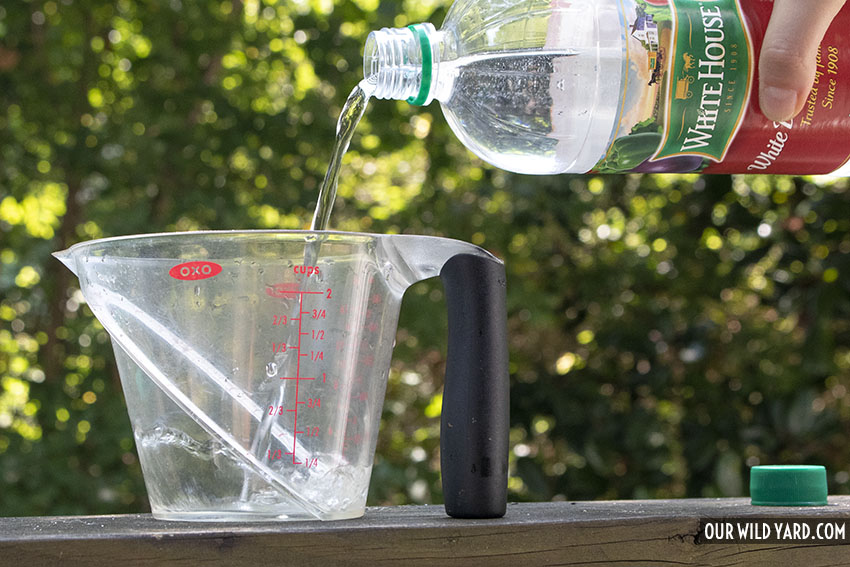
Bleach: Keep in mind that the National Wildlife Health Center suggests in their recent statement that you should “clean feeders and bird baths with a 10% bleach solution (1 part bleach mixed with 9 parts water), rinse with water and allow to air dry.” The Cornell Lab of Ornithology also recommends using a dilute bleach solution to clean bird feeders, (though when it comes to birdbaths they simply recommend to change the water every couple days, and to scrub it vigorously).
While bleach is certainly most effective, it has some drawbacks as well. It creates hazardous fumes that are dangerous to breathe so only use it in well-ventilated areas. And if you dump it outside you’ll likely kill your grass and other plants or small creatures it comes in contact with. You must be sure to thoroughly rinse the bleach from the bath with fresh water and let it air dry to remove any remaining bleach. Vinegar will also kill plants so in this aspect it’s kind of a tie.
How To Clean a Bird Bath With Vinegar (or Bleach)
1) Dilute Vinegar With Water
Using any white vinegar, mix 1 part vinegar with 9 parts water. The recipe is exactly the same for bleach. We used a 2-cup measuring cup that actually holds about two and a half cups when filled to the top. That way we could add 1/4 cup of vinegar or bleach then fill it the rest of the way with tap water. If you’re using bleach, either open & mix it outside or open a window for proper ventilation. We used vinegar in our example.
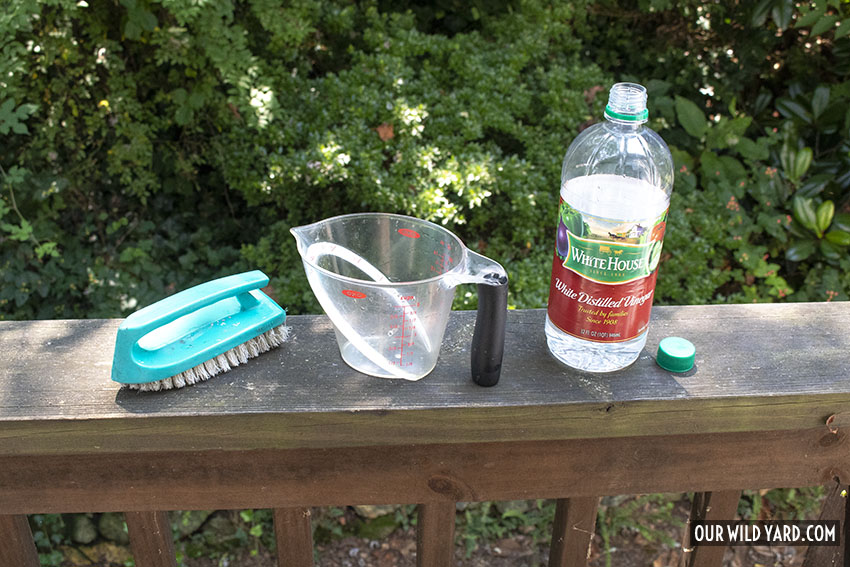
2) Fill a Cooking Pot With Cold Tap Water
Or a watering can or whatever. We used a pretty bottle just to make the photos look nice ?. Take the fresh water and disinfectant solution to the bird bath.

3) Get scrubbing
Dump the old water from the bath (and any leaves or debris that have accumulated) and pour in a splash of fresh water. Grab a stiff handled scrub brush and scrub the entire inside of the bath vigorously to remove all algae and debris. Micro-organisms will shelter in the tiny crevices so if you don’t remove all the crud, then it’s nearly impossible to fully disinfect your birdbath!

4) Rinse
Add some more clean water and rinse out all the junk you just scrubbed out. You should now have a clean slate to work with.
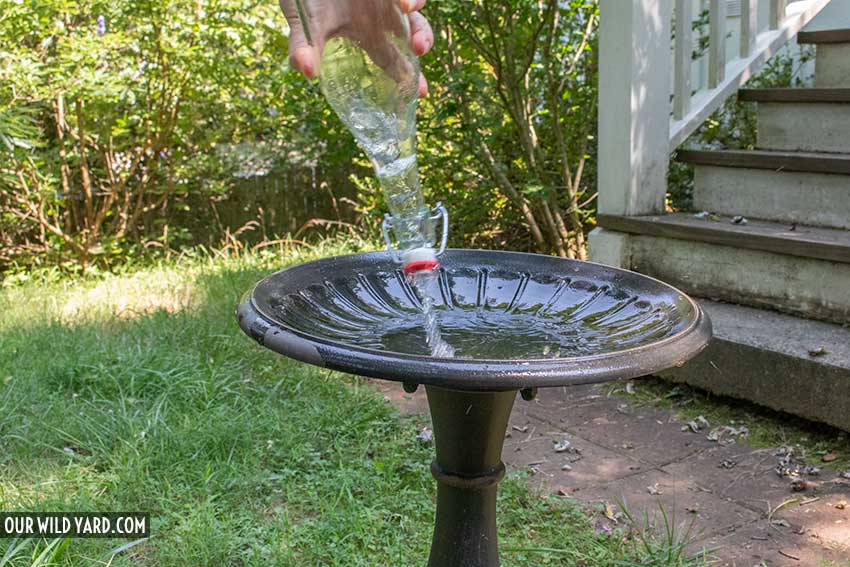
5) Disinfect
Pour in your disinfectant vinegar or bleach solution. Swirl it around in the bath to reach every surface. You can scrub it around with the brush as well (after you’ve rinsed the crud out of your brush).
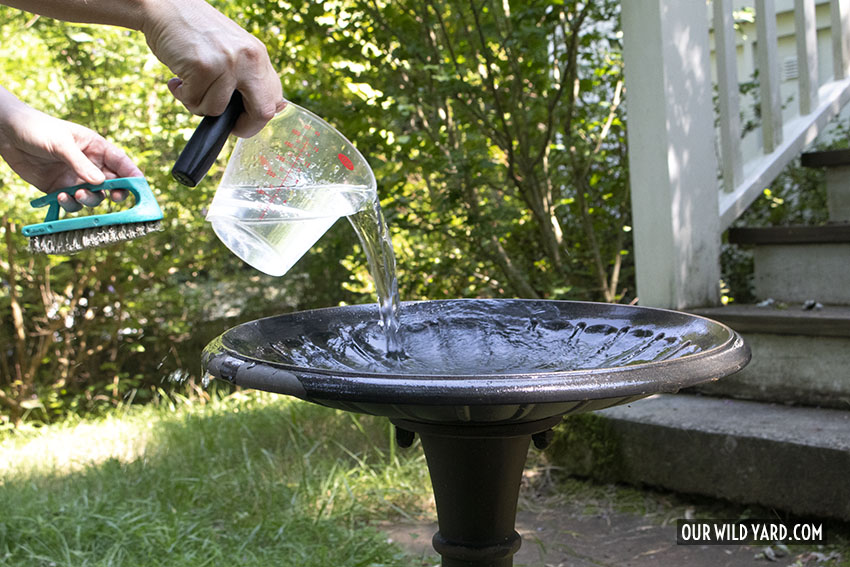
6) Let disinfectant sit on surfaces for 10 minutes
Technically, bleach requires a full 10 minutes of contact time for full effectiveness. Vinegar also becomes more effective with a 10 minute exposure time. If you do follow this step, be sure no birds use the bath during this time if you’re using bleach. It is poisonous to drink! Either cover it with a garbage can lid or keep an eye on it.
7) Rinse thoroughly
Keep in mind that both bleach and vinegar will kill plants so either dump the used disinfectant very carefully or pour it somewhere you want to kill weeds like a crack in your driveway. Then rinse the bath thoroughly with more clean water.
8) Allow to air dry
Set the bird bath in the sun and let it dry. Bleach breaks down fairly quickly when exposed to water and sunlight so that will help remove any residual disinfectant.
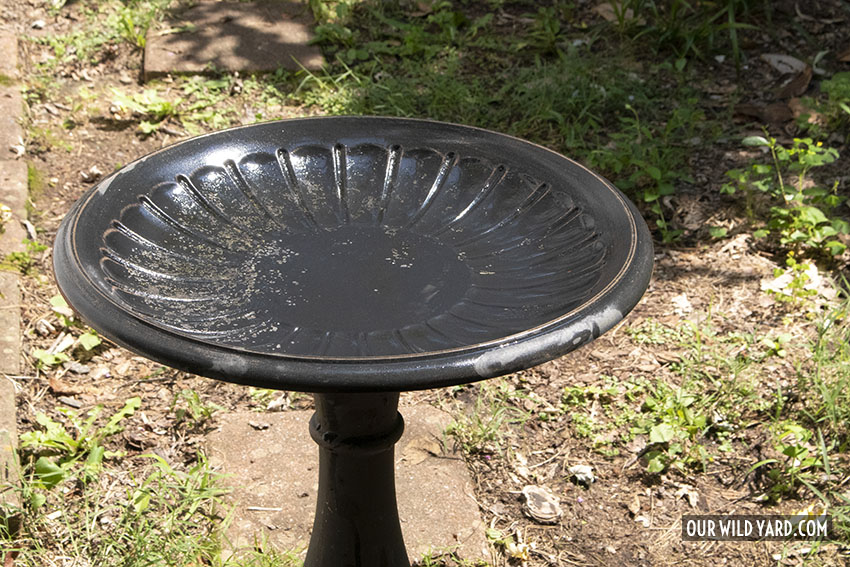
9) Refill the bird bath!
Once the bath has completely dried, move the bath back into position, grab another pot of cold tap water, and fill it up! 2 inches maximum depth is ideal. Congratulations, you have a clean bird bath!
How to Prevent Green or Red Algae in Bird Bath
You may discover green or red algae in your bird bath. This is normal and not harmful to birds, but it will provide an easy place for microorganisms to hide when you’re trying to disinfect. It also may make the bath less attractive to birds if it looks stagnant.
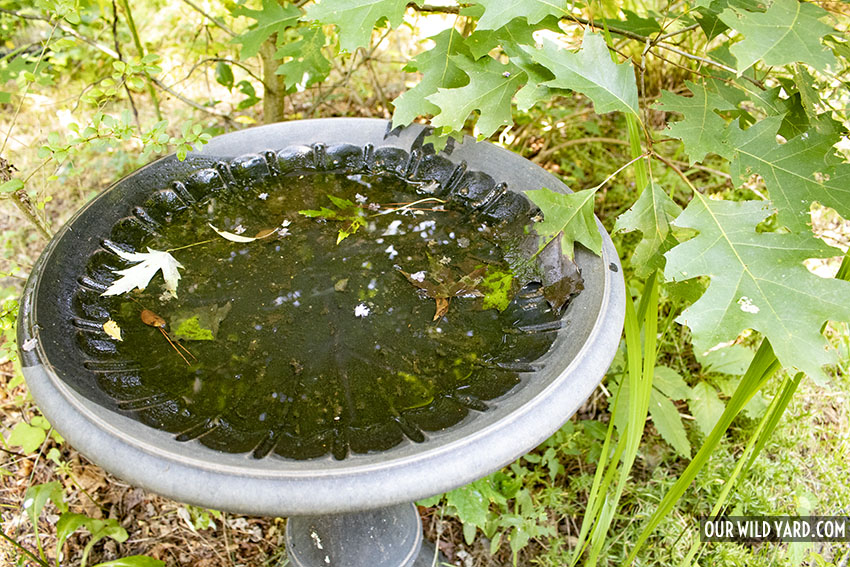
If you see algae, it’s a good indicator that you’re not changing your water frequently enough. Here are some tips on how to prevent algae in a bird bath:
- Keep your bird bath in the shade. Sunlight and heat both promote algae growth. Shade will cut down on both.
- Clean your bath regularly. Follow the simple instructions at the top of this post. Basically, change the water and scrub off the algae every couple days with a scrub brush. Using vinegar when you clean can also help inhibit future algae growth.
- Don’t place the bath directly under a shrub or tree. Algae can be transferred to your bath from objects falling into it like leaves. However it can also arrive on bird feet or the wind so don’t get too crazy about this one. I think it’s more important to have shrubs or trees nearby that birds can use for drying, preening, and shelter, than to worry too much about how to prevent algae in a bird bath!
How to Clean a Concrete Bird Bath
The instructions for how to clean a concrete bird bath are identical to the ones above (jump to: How to Keep Bird Bath Clean) except you have to pay special attention to the scrubbing step.
While concrete and cement bird baths may make a nice lawn ornament, they’re not ideal for birds because concrete (cement) can have lots of small crevices where algae and microorganisms (like bacteria and viruses) can hide, so you have to scrub longer and more thoroughly. What about how to clean a cement bird bath with vinegar or bleach? It’s the same as our steps above in How to Clean a Bird Bath With Vinegar but it’s even more important to allow 10 minutes of exposure to the disinfecting solution so it can penetrate the nooks and crannies (and don’t forget to really focus on the scrubbing).
Another problem with most cement bird baths is that they tend to be too deep. The ideal shape of a bird bath should mimic a natural puddle with shallow sloping sides and about 2 inches maximum depth of water. If your cement bath is too deep you could either fill it less or place a few stones in it that birds can stand on.
Great job! Pat yourself on the back! Now that you’ve learned how to clean a bird bath, you’ll get in the habit of doing the basic maintenance every couple days. You’ll have way more birds enjoying your bath, and you’ll keep everyone more healthy, from birds to humans!


Thanks guys. It is very useful for sharing the way to clean bird bath and prevent disease. Dirty water can make the birds sick and they can spread diseases to other birds in their flock.